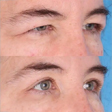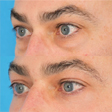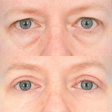Thyroid Eye Disease
Conveniently located to serve the areas of Chicago, IL

Thyroid Eye Disease (TED), also known as Graves’ ophthalmopathy or orbitopathy, is a condition that affects the eyes and surrounding structures due to an autoimmune disorder. This condition can cause a range of symptoms including proptosis (bulging eyes), diplopia (double vision), eyelid retraction, eye swelling, and even optic neuropathy in severe cases.
At Chicago Oculofacial Plastic Surgery, a Center of Excellence for the diagnosis and treatment of TED, Dr. Paul Phelps has partnered with ThrIVe Health to provide effective IV infusions for patients with TED, as well as offering targeted surgical procedures for the condition. With his extensive experience and dedication to achieving optimal outcomes, Dr. Phelps strives to help patients regain their confidence and improve their quality of life.
If you are experiencing symptoms related to TED, we invite you to contact our office at (312) 888-5754 to schedule a consultation with Dr. Phelps at our conveniently located Chicago practice.
Contents
About Thyroid Eye Disease
TED affects roughly 16 women and 3 men per 100,000 people. (1) It is a manifestation of an autoimmune disorder, typically associated with an overactive thyroid gland, but also may occur in patients with normal or low thyroid levels. The immune system mistakenly attacks the tissues around the eyes, leading to various ocular symptoms. One of the most prominent features of thyroid eye disease is the bulging or protrusion of the eyes, medically referred to as proptosis. This can result in a significant change in appearance. Other common symptoms include:
- Swollen Eyelids
- Double Vision
- Dryness
- Inflammation
- Eye Discomfort
In severe cases, TED can even lead to vision problems such as double vision or difficulty closing the eyelids due to eyelid retraction. This can cause both physical discomfort and emotional distress for patients.
“TEPEZZA is now the first treatment I use to help patients early in the course of the disease,” says Paul Phelps, M.D., F.A.C.S., Functional & Cosmetic Ophthalmic Plastic Surgery, NorthShore Medical Group. “The improvement in eye bulging and double vision can be dramatic and can help patients look more like themselves.”
What is an Overactive Thyroid?
An overactive thyroid, also known as hyperthyroidism, is a condition where the thyroid gland produces an excess amount of thyroid hormones. The condition can manifest in different ways, with Graves’ disease being the most common cause. (2) Graves’ disease occurs when the immune system mistakenly attacks the thyroid gland. This can result in symptoms such as:
- Weight Loss
- Rapid Heart Rate
- Anxiety
- Irritability
- Tremors
- Difficulty Sleeping
In severe cases, a thyroid storm may occur, which is a life-threatening condition characterized by high fever, rapid heartbeat, and altered mental status. (3)
Personal Consultation
A comprehensive personal consultation at our state-of-the-art practice in Chicago is the first step towards addressing your concerns related to TED. Led by oculofacial plastic surgeon Dr. Paul Phelps, we prioritize understanding your medical history and discussing your specific cosmetic and functional needs.
During the consultation, Dr. Phelps will conduct a thorough examination of your eyes, focusing on the skin, muscles, and underlying structures. This evaluation allows him to assess the extent of orbital inflammation and determine the severity of eyelid retraction, double vision, bulging eyes, and potential optic nerve compression.
Thyroid eye disease can significantly impact both the appearance and function of your eyes, causing discomfort and affecting your overall quality of life. Dr. Phelps’s expertise in oculofacial plastic surgery uniquely positions him to provide tailored recommendations based on the complexities of your case.
If you are experiencing eye issues due to TED, we encourage you to reach out to our practice at (312) 888-5754 to schedule a consultation with Dr. Phelps. During this consultation, he will thoroughly evaluate your condition, discuss your goals and concerns, and develop a personalized treatment plan tailored to your unique needs.
What are Tepezza Infusions?
Chicago Oculofacial Plastic Surgery is a Center of Excellence for Tepezza infusions. Tepezza, or teprotumumab-trbw, is an FDA-approved medication specifically designed to target the underlying cause of thyroid eye disease. It is a monoclonal antibody that works by inhibiting the insulin-like growth factor receptor, which plays a crucial role in the development of the condition. (4) By reducing inflammation and swelling, Tepezza can effectively alleviate many of the distressing symptoms associated with thyroid eye disease.
How Does IV Treatment for TED Work?
The treatment process typically involves a series of infusions administered over several months. Each infusion session takes place in Dr. Phelps’ office, ensuring the safety and efficacy of the procedure. Patients may experience improvements in their symptoms within weeks of starting Tepezza, with optimal results after completing the full treatment course.
Who is a candidate for Tepezza Infusions?
It is important to note that Tepezza is not suitable for everyone with thyroid eye disease. A thorough evaluation and consultation with a skilled oculofacial plastic surgeon are necessary to determine the appropriateness of this treatment option for each case.
The LIDS Study
We are currently enrolling patients with TED in clinical trials in partnership with Sling Therapeutics and ThrIVe Health. The name of the trial is Linsitinib IGF Drug Study (LIDS). This trial seeks to examine the effectiveness of a new medication for TED called linsitinib, an IGF-1R inhibitor. Put simply, linsitinib is a small molecule inhibitor, an organic compound that targets the cause of TED. The outcome of a similar study has been encouraging, indicating that this medication improves thyroid function. (5)
You may qualify to be a LIDS study participant if:
- You are at least 18 years of age or older.
- You have been diagnosed with active, moderate-to-severe TED in the past year.
- You have been diagnosed with Graves’ disease or Hashimoto’s disease related to TED.
The LIDS study will examine the effectiveness of linsitinib by splitting its participants at random into three groups.
- One group will take twice-daily doses of 150mg linsitinib.
- One group will take twice-daily doses of 75mg linsitinib.
- One group will take twice-daily doses of a placebo pill.
This oral medication may be a promising treatment option for TED. If you are interested in being part of this study, or if you would like to learn more about it, please contact Chicago Oculofacial Plastic Surgery at (312) 888-5754.
Surgical Procedures for TED
Orbital Decompression
Orbital decompression surgery can be a highly effective treatment option for TED. This specialized ophthalmic procedure aims to create more space within the orbit by removing excess fat and/or bone. By doing so, the surgeon relieves pressure on the optic nerve, allowing the eyes to return to a more natural position and reducing symptoms such as bulging eyes, swollen eyelids, and double vision.
Eyelid Retraction Surgery
Surgical treatment for eyelid retraction focuses on restoring a natural and balanced position of the eyelids. Dr. Phelps utilizes advanced techniques such as eyelid repositioning surgery and eyelid malposition correction to correct the abnormal eyelid placement. By carefully adjusting the tension and positioning of the eyelids, he achieves optimal results that enhance both aesthetics and functionality.
Other Interventions
In some cases, strabismus (eye misalignment) surgery may be required for people with TED. In these cases, Dr. Phelps will refer cases to a trusted pediatric ophthalmologist colleague. Additionally, he may refer patients with optic neuropathy to a neuro-ophthalmologist for additional monitoring.
Cost of Thyroid Eye Disease Treatment in Chicago
The cost of your TED treatment will depend on your unique plan. If you are interested in receiving Tepezza infusions, if you would like to find out more about surgical options for thyroid eye disease, or if you would like to participate in the LIDS study, please get in touch with us. Call (312) 888-5754 or use our simple form to contact Chicago Oculofacial Plastic Surgery.
Read more about TED in Dr. Phelps’ interview with CBS News.
FAQ
Can thyroid eye disease be cured?
Thyroid eye disease cannot be cured completely, but its symptoms can be managed effectively with appropriate treatment. The goal of treatment is to control the progression of the disease, alleviate symptoms, and improve the overall appearance and function of the eyes. Regular follow-up visits with an experienced oculofacial plastic surgeon are essential to monitor the condition and make necessary adjustments to the treatment plan.
Can TED affect vision?
Yes, thyroid eye disease can potentially affect vision, especially if left untreated or in severe cases. The bulging of the eyes (proptosis) can lead to exposure of the cornea, making it more susceptible to dryness and irritation. In some cases, the optic nerve may be compressed, resulting in vision loss or double vision (diplopia). Prompt diagnosis and appropriate treatment are crucial in preventing vision complications and preserving eye health.
Is surgery the only option for treating thyroid eye disease?
No, surgery is not always the first line of treatment for thyroid eye disease. The management approach depends on the severity of the symptoms and the individual patient’s condition. In mild cases, conservative measures and medical therapies may be sufficient. However, if symptoms persist or worsen despite non-surgical treatments, surgical interventions such as orbital decompression or eyelid surgery may be recommended to achieve optimal results.
Is thyroid eye disease a common condition?
Thyroid eye disease is relatively rare but can have a significant impact on those affected by it. It most commonly occurs in individuals with Graves’ disease, an autoimmune disorder that affects the thyroid gland. While not everyone with Graves’ disease will develop Thyroid Eye Disease, it is estimated that about 40% of patients with this condition will experience some degree of eye involvement. (6)
References
- BARTLEY GB, FATOURECHI V, KADRMAS EF, et al. The Incidence of Graves’ Ophthalmopathy in Olmsted County, Minnesota. American Journal of Ophthalmology. 1995;120(4):511-517. doi:https://doi.org/10.1016/s0002-9394(14)72666-2
- De Leo S, Lee SY, Braverman LE. Hyperthyroidism. The Lancet. 2017;388(10047):906-918. doi:https://doi.org/10.1016/s0140-6736(16)00278-6
- Pokhrel B, Bhusal K. Thyroid Storm. PubMed. Published 2020. https://www.ncbi.nlm.nih.gov/books/NBK448095/
- Douglas RS, Kahaly GJ, Patel A, et al. Teprotumumab for the Treatment of Active Thyroid Eye Disease. New England Journal of Medicine. 2020;382(4):341-352. doi:https://doi.org/10.1056/nejmoa1910434
- Gulbins A, Horstmann M, Anke Daser, et al. Linsitinib, an IGF-1R inhibitor, attenuates disease development and progression in a model of thyroid eye disease. Frontiers in Endocrinology. 2023;14. doi:https://doi.org/10.3389/fendo.2023.1211473
- Chin YH, Ng CH, Lee MH, et al. Prevalence of thyroid eye disease in Graves’ disease: A meta‐analysis and systematic review. Clinical Endocrinology. 2020;93(4):363-374. doi:https://doi.org/10.1111/cen.14296
- Phelps PO, Williams K. Thyroid eye disease for the primary care physician. Disease-a-Month. 2014;60(6):292-298. doi:https://doi.org/10.1016/j.disamonth.2014.03.010


